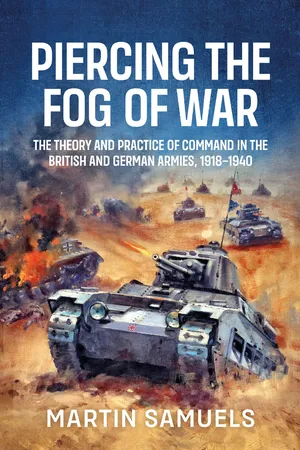
Piercing the Fog of War
The Theory and Practice of Command in the British and German Armies, 1918-1940
- 332 pages
- English
- ePUB (mobile friendly)
- Available on iOS & Android
Piercing the Fog of War
The Theory and Practice of Command in the British and German Armies, 1918-1940
About this book
Since the late 1970s, anglophone and German military literature has been fascinated by the Wehrmacht's command system, especially the practice of Auftragstaktik. There have been many descriptions of the doctrine, and examinations of its historical origins, as well as unflattering comparisons with the approaches of the British and American armies prior to their adoption of Mission Command in the late 1980s. Almost none of these, however, have sought to understand the different approaches to command in the context of a fundamental characteristic of warfare – friction. This would be like trying to understand flight, without any reference to aerodynamics. Inherently flawed, yet this is the norm in the military literature. This book seeks to address that gap. First, the nature of friction, and the potential command responses to it, are considered. This allows the development of a typology of eight command approaches; each approach then being tested to identify its relative effectiveness and requirements for success. Second, the British and German armies' doctrines of command during the period are examined, in order to reveal similarities and differences in relation to their perspective on the nature of warfare and the most appropriate responses. The experience of Erwin Rommel, both as a young subaltern fighting the Italians in 1917, and then as a newly-appointed divisional commander against the French in 1940, is used to test the expression of the German doctrine in practice. Third, the interaction of these different command doctrines is explored in case studies of two key armoured battles, Amiens in August 1918 and Arras in May 1940, allowing the strengths and weaknesses of each to be highlighted and the typology to be tested. The result is intended to offer a new and deeper understanding of both the nature of command as a response to friction, and the factors that need to be in place in order to allow a given command approach to achieve success. The book therefore in two ways represents a sequel to the author's earlier work, Command or Control? Command, Training and Tactics in the British and German Armies, 1888-1918 (London: Cass, 1995), in that it both takes the conceptual model of command developed there to a deeper level, and also takes the story from the climax of 1918 up to the end of the first phase of the Second World War.
Frequently asked questions
- Essential is ideal for learners and professionals who enjoy exploring a wide range of subjects. Access the Essential Library with 800,000+ trusted titles and best-sellers across business, personal growth, and the humanities. Includes unlimited reading time and Standard Read Aloud voice.
- Complete: Perfect for advanced learners and researchers needing full, unrestricted access. Unlock 1.4M+ books across hundreds of subjects, including academic and specialized titles. The Complete Plan also includes advanced features like Premium Read Aloud and Research Assistant.
Please note we cannot support devices running on iOS 13 and Android 7 or earlier. Learn more about using the app.
Information
Table of contents
- Cover
- Title
- Copyright
- Contents
- List of Maps
- Acknowledgements
- Permissions
- Note on Naming Conventions
- Abstract
- About the Author
- 1 Friction and Command: Developing a Model of Command Approaches
- 2 Doctrine for Orders and Decentralisation
- 3 Erwin Rommel and the Application of German Doctrine
- 4 The British Tank Assault at Amiens, 8 August 1918
- 5 The British Armoured Counterattack at Arras, 21 May 1940
- 6 Epilogue
- Bibliography